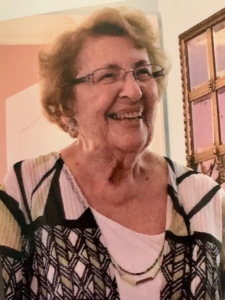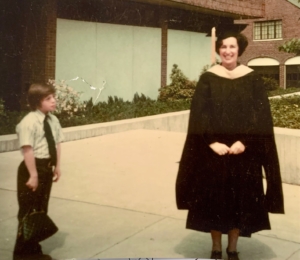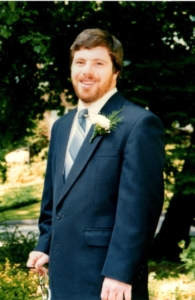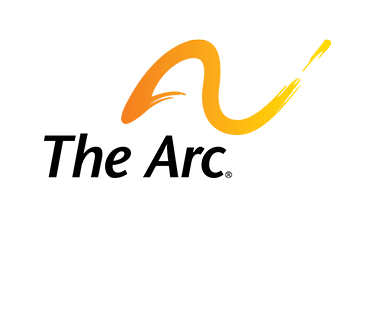When Bruce Entered My Life
By Evelyn Baron, written in 1991
 In 1964, at age 40, I was happily married for 17 years and the mother of three children—a daughter, 14, and sons, seven and 10. With all three children in school, I decided to enter college to fulfill a lifelong dream. Shortly after I started, I found out I was pregnant. I was stunned. Life changed for all of us once my baby, Bruce, was born. But my desire to attend college never waned. I started taking courses on nights, weekends, and in the summer, juggling my responsibility to four children and to my aging parents.
In 1964, at age 40, I was happily married for 17 years and the mother of three children—a daughter, 14, and sons, seven and 10. With all three children in school, I decided to enter college to fulfill a lifelong dream. Shortly after I started, I found out I was pregnant. I was stunned. Life changed for all of us once my baby, Bruce, was born. But my desire to attend college never waned. I started taking courses on nights, weekends, and in the summer, juggling my responsibility to four children and to my aging parents.
When Bruce was two, he wasn’t walking, but I hadn’t been alarmed because my third child had also walked late. I took him to the pediatrician. After running some tests, the doctor told us Bruce had Down syndrome. The doctor then described that Bruce would be like a puppy dog we would pet.
I was in total shock and don’t remember how I drove home. The next few days remain a blur as his words rang over and over in my head. My beautiful baby, how could he be likened to an animal? Would it be different now that we found out he had Down syndrome? No way.
We continued to treat him the same, he was no different than he had been the week before his diagnosis. I can still hear my third child saying, “No matter what, he’s my brother…”. I also remember well my response to an acquaintance when she asked if I would place him in an institution. I let her know that this was my baby she was talking about and that he had his home with us, just like any of our other children.
Our children were wonderful—they continued to teach him and to expect from him all that he could, and he prospered and grew from this loving environment. Our friends and families rallied to give us respite when we needed them. He was eager to learn at his own pace, and we were always there to give him the assistance he needed.

Back at college, I started taking courses to learn more about disability to help me in raising my child. I finalized my major as rehabilitation and started to take internships at facilities where there were people with disabilities.
Finally, after attending classes part-time for 10 years, I had amassed the needed 130 credits and graduated Cum Laude. I watched the local papers to put my education to work. I saw an ad for an executive director for The Arc in Enfield, Connecticut. When I applied, the parent volunteers who posted the listing explained how I would be their first Executive Director to start much-needed programming.
With little knowledge of how to get programs started but strong determination, I proceeded to initiate numerous programs and services. Wherever there was a possibility of a grant, I was there, and we were most times successful. For the next 16 years, I found myself working long hours, meeting with families and boards of directors, and working closely with town, state, and federal legislators and school systems. It was always a labor of love. As Bruce’s mother, I would often boast of his and others’ achievements to groups when I spoke to help them understand how these people had the right and ability to live and work in the community. We started group homes where neighbors at first were apprehensive. I remember a meeting in the home of one where I was confronted by an angry group. I let them know our people would be good neighbors and they had nothing to fear. I let them know how as a mother, what had happened to me could happen to any of them, and it would be them begging to give our people a chance, just like I was. They accepted the homes and never had a problem again. Before I retired three years ago, I succeeded in building for Enfield a large new building to house their many programs. No more church basements, old schools—they have their own beautiful building.
Bruce has always amazed us with his extraordinary level of understanding and compassion. We threw out the books long ago that said how limited he would be. After many years of Bruce and I trekking 60 miles to Sunday school (no other schools that were closer to us would accept him), at 13 Bruce had his Bar Mitzvah, something he wanted. When he said the prayers he studied, he stood there so proudly. Every one of our 200 guests, including the Rabbi and Cantor all cried for joy as he took his rightful place within the congregation.
We have tried for Bruce to have as near a normal life as possible. He’s always had many friends, went to camp, junior, and senior high school, and when he graduated, he started to work as a bagger at a local market, where he still works. They continually tell us what a fine worker he is. There are now many people with disabilities working, and it makes me proud that I was at the forefront of helping this to happen.
Bruce, now 25, continues to live at home. He remains an integral part of our lives.
When Bruce was diagnosed, we received the news as a tragedy—but over Bruce’s life, we realized the real tragedy was the limitations people placed on him.

Five years after this was written, Bruce passed away.
Bruce would have given the shirt off his back throughout his life to care for someone, so his family continued his legacy of giving even after his passing through organ donation. One recipient, Tom, was given Bruce’s liver and became an unofficial part of the family. He remains close with them to this day and thanks Bruce and Evelyn for his gift of life.
Hundreds of community members attended Bruce’s funeral and spoke about how he influenced their lives and shattered their misperceptions. Bruce’s life—and Evelyn’s fierce advocacy—fundamentally changed their community and helped move the needle on people’s perceptions of what is possible for someone with a disability when they have the support of family and community.








